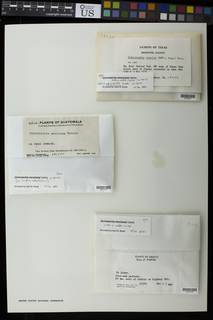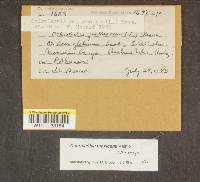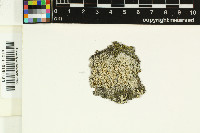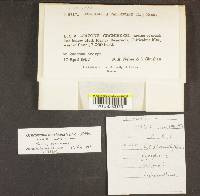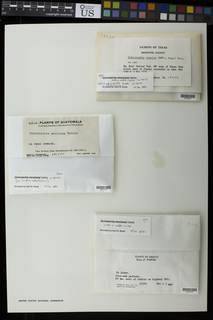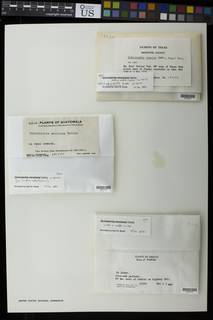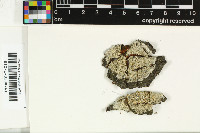
Consortium of Lichen Herbaria
- building a Global Consortium of Bryophytes and Lichens as keystones of cryptobiotic communities -
- Home
- Search
- Images
- Species Checklists
- US States: O-Z >
- US National Parks
- Central America
- South America
- US National Parks
- Southern Subpolar Region
|
|
|
|
Family: Ochrolechiaceae
|
Nash, T.H., Ryan, B.D., Gries, C., Bungartz, F., (eds.) 2004. Lichen Flora of the Greater Sonoran Desert Region. Vol 2. Thallus: crustose, rimose-verruculose and somewhat undulating or veriform in the center; prothallus: rarely visible, very thin, white, shiny areoles: thin surface: yellowish white to yellowish gray, smooth at edge, becoming rugose in center, continuous; soredia: most commonly absent , but present in a morphotype, when sterile, forming small patches of granulose soredia on a rimose-verruculose thallus, when fertile (only one specimen seen by Brodo (1991)), producing hemispherical mounds of farinose soredia, seeming to grade into granular soredia in places Apothecia: lecanorine, at first sessile, then somewhat constricted, but remaining relatively thin, 0.8-1.5(-2.2) mm in diam. disc: very pale, orange-yellow to less frequently orange, epruinose to lightly pruinose or crusty (rarely heavily pruinose), often rough in mature apothecia, smooth in young, K+ light yellow, C+ red, KC-, P- margin: smooth, even to somewhat flexose, hardly prominent above disc and merging with it, especially in young apothecia, giving a saucer-like appearance, sometimes showing an excipular ring or discoid tissue amphithecium: medulla: lax, sometimes with small K-insoluble crystals; algal layer: thick, internal to cortex and forming a layer, usually unbroken, below hypothecium, thus enveloping the amphithecial medulla; cortex: distinct, gelatinous, 20-35 µm thick laterally, expanding to 70 or even 150 µm at base exciple: 10-25 µm thick, often expanding laterally hymenium: often with abundant oil drops, 180-280 µm tall; hypothecium-subhymenium: quite thick, 35-70 µm, also with oil drops asci: 8-spored ascospores: hyaline, simple, ellipsoid, 38-60 x 19-28 µm Pycnidia: not seen Spot tests: Chem Race I (most common, all but four specimens seen by Brodo [1991]): cortex and medulla: K-, C+ pink to red, KC+ red, P-; thallus and apothecia cortex: UV+ bright yellow-orange; Chem Race II (rare, but includes holotype): same as I, but amphithecial medulla C- Secondary metabolites: Chem. Race I: gyrophoric, lecanoric and 4,5-di-O-methylhiascic acids, and lichexanthone; Chem. Race II: same as I but lacking 4,5-di-O-methylhiascic acid. Substrate and ecology: on bark of all types including Alnus, Acer, Pseudotsuga, and Pinus in oak and conifer stands at elevations of 580-3000 m World distribution: Chem. Race I: Applachian-Great Lakes region, montane Arizona, New Mexico, Mexico and Guatemala; Chem. Race II: Arizona, Texas, Mexico and Guatemala; sorediate morphotype: New Mexico, Texas and Mexico along the Sierra Madre Oriental Sonoran distribution: Chem. Race I: montane southwestern Arizona, eastern Sonora, western Chihuahua and northern Sinaloa; Chem. Race II: southwestern Arizona, central Sinaloa. Notes: Differences between O. mexicana and O. africana, which are closely chemically related, are discussed under the latter species. The distinction with O. arborea is discussed under that species. |
Powered by Symbiota







